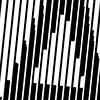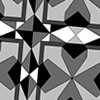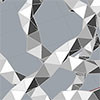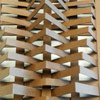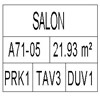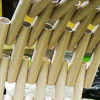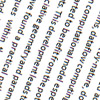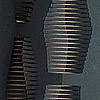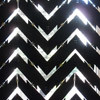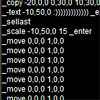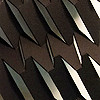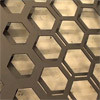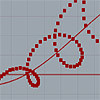This is a macro exercise in Rhino, showing that Rhino is pretty much capable of automating some cool text effects. Just copy and paste the below code into the command bar of the Rhino, or open the macro editor by typing macro edit, then paste it there and press play. You’ll enter any string when prompted, then the macro handles the rest of the process. You can play with the […]
Again, we revisited the seamless patterns exercise this semester. This is one of the main exercises of architectural geometry class. We expected to improve students reasoning on generative patterning while they explain their processes step by step. The key element of this exercise is the usage of compass and ruler constructions. However, we didn’t keep this rule limiting their creativity too much. In this activity, we tasked students with developing a personalized […]
This is the Grasshopper definition that generates a tetrahedral helix (also called as Boerdijk-Coxeter helix) but in a funny way. This geometry is also a solution for tangent spheres. I generated the helix using Anemone components for recursion and gave it a little bit of responsiveness. I don’t know if it depends on the speed of your CPU but if it is slow enough, you’ll see the snake game of tetrahedral […]
Here are some of the student works from this year’s Computation-based Basic Design Studio, centered around the captivating theme of Metamorphosis. Throughout the course, we tasked the students with pushing the boundaries of their creativity and innovation and encouraged them to construct designs that transcend conventional limitations and embody the essence of shapeshifting systematic wholes. The metamorphosis concept catalyzed their artistic exploration. Then, urged them to delve deep into the […]
We are back! Here are some Revit components I’ve created for a project. These and other cool downloads can be found at revitcity.com T_Room Tag T_Parking Space T_Door Tag A Door
This is an interesting material project of this year’s computation-based Basic Design II studio. Students experienced a well-known structural system tensegrity, composed of cables, joint details, and aluminum sticks. Although their overall macro form had serious problems, the exploratory process of this group was very successful. *Students: Deniz Ağaoğlu, Fatma Sezgin, Serkan Ateş, Aysel Abasova, Kardelen Kıroğlu, Sedat Tolga Kalcıoğlu, İlayda Yörük, Nikol Sergici, Kıvılcım Dişli, Uğur Polat
Here is another computation-based Basic Design II final project. It is made of paper tubes, joined angular by nuts and bolts in order to give the desired form. This group had serious problems with project development and exploration, but anyway they managed to finish this inspirational prototype. *Students: Abdullah Selim Buldu, Ecem Aksoy, Lachyn Tuliyeva, Neda Khorshidi, Selenay Geyik, Sevgi Yücel
A mid-15th-century Ottoman recipe, mantı is filled with pounded lamb and crushed chickpeas, steamed, and served topped with yogurt mixed with crushed garlic and sprinkled with sumac. In modern Turkish cuisine, mantı is typically served topped with yogurt and garlic, and spiced with red pepper powder and melted butter, and with ground sumac and/or dried mint. Although there are many different variations of mantı in terms of shape and way of […]
Another Turkish translation from my Ph.D. The paper is titled “CAD Smart Objects: Potentials and Limitations”, presented by Magdy Ibrahim, Robert Krawczyk, and George Shcipporeit at the 21st eCAADe Symposium in 2003. It is a brief introduction to today’s CAD and BIM concepts. You can find this paper in CuminCAD’s database. Below is the Turkish version, which I translated in 2005: CAD SMART OBJECTS: POTENTIALS AND LIMITATIONSMagdy Ibrahim, Robert Krawczyk, […]
This is my Turkish translation of the 1997 article by Charles Jencks, “Nonlinear Architecture: New Science = New Architecture?”. Very short but the cult text explains the emergence of a new technology-based architecture. Although very old, it is still an up-to-date discussion for computational design research. NON-LINEAR ARCHITECTURE: NEW SCIENCE = NEW ARCHITECTURE ? Charles Jencks Yüz yıldan beri pekçok mimar yeni oluşan yaşam koşullarının yeni bir mimarlığı doğuracağını söylemişlerdir. […]
Third and the final outcome of the Animate Patterning workshop is coordinated by Mehmet Ali. Students tried to develop a kirigami-like surface animation (which is also a good solution to my one-servo question) while they studies numerous variations. They ended up with this panel, ready to be moved by Arduino; The workshop is organized together with Mehmet Ali Altın and Fulya Akipek. Students are, Murat Akırmak, Gizem Ceyhanlıer, Cem Kıyak, […]
Here is another student project from the three-day workshop we conducted together with Fulya Akipek and Mehmet Ali Altın. Briefly, the idea was to develop a system of cogwheels that spin together to animate an entire pattern. It was about to develop a kinetic system with a simple Arduino-based setup, probably with one servo and a motion sensor. The integration of the cogwheels system and the underlying pattern was interesting […]
This is one of the works of the three-day workshop at Eskişehir Anadolu University, called “Animate Patterning“. This project is based on our previous folding experiment posted here, while students advanced it, testing a folding style called “Miura”. They built a 2.5m x 1m folding pattern, explained briefly here. After analyzing, and testing the folding technique, they drew the tessellation composed of a single parallelogram. They joined the structure together with hinges and […]
It seems that our first-year students of architecture, interior design, and industrial design take Rhino’s macro functionality very seriously. This encourages us to study algorithmic techniques more and more in the freshman year Design Computing class. Below are some of the results of this week’s assignment. They explicated the modeling process of their prototiles into macro codes, ready to be molded. Zeynep Dutipek developed the macro to reconstruct her prototile with different parameters. She […]
Inspired by this cut-fold pattern, we developed a prototype with Fulya Akipek. The first experiments were made from 3mm thick foamboards and they worked very well with 50×70 plates. However, when the project gets bigger and bigger, we needed to add a joint detail and use 5mm thick foamboards to achieve our goal (that is to develop a 1m by 2.5m shutter system). Then, we tried to animate its folding behavior by […]
This is one of the ideas we’ve tested for the workshop “Animate Patterning“. Inspired by this work, Apart from the pattern that turns around, the torque, rotation radius and speed of the servo, weight, connection detail, and a number of foamboards become important inputs for this design. In the three-day workshop, one group of students interpreted this idea of using several moving layers and creating an emergent pattern at the […]
This is a Cycloid-like family of curves, generated by its classical description: a rolling circle. I had several other studies on similar topics before. In this cycloid experiment, I used Grasshopper in which, we don’t need to roll the circle. Instead, we can divide a parametric curve, utilizing data lists to simply rotate a circle around it. Finally, evaluating the circle repeatedly creates a Cycloid-like result. I found this as […]

